
|
Collecting in the Snowy Range Mountains by Richard L. Howey, Wyoming, USA |
On August 21, 2008, my friend Todd Harris and I set out to do a bit of collecting in the Snowies. We drove to Centennial, Wyoming, a thriving metropolis of 100 people. Centennial sits at the base of the range. It has several bars and eating establishments which are fairly good provided you like very large steaks and lots of fries. This is not a village for vegetarians nor teetotalers for that matter. There are several gift shops for the tourists, a lodge, a tiny train museum outside of which is a caboose painted a bright yellow which was once owned by a friend of ours who, in recent years, has been living on a boat along the coast of northern Washington. Along the highway that runs through the village, there is alongside the road, about half way through, there is a State Patrol car. The highway speed is 65 mph and the speed in Centennial is 30 mph. It is a Potemkin Patrol Car and sometimes there is a dummy sitting in the driver’s seat, but on this day there wasn’t.
The altitude of Centennial is 8,076 feet and when we reached the top at Lake Marie, we would be a bit over 10,500 feet. The drive up is spectacular and our first stop was at Barber Lake which a few years ago was almost without water because of the drought, but this year was full and flourishing.

This year, however, I was rather saddened. There were a significant number of fir trees which were dead and all of the needles had turned from their usual lovely forest green color to an horrific reddish-brown. They were victims of pine beetle. To the south of us, down in Colorado, staggering numbers of evergreens have been killed by pine beetle, radically increasing the danger of wildfires. The beetles burrow beneath the bark, but they also carry a blue stain fungus which infects the trees. Female beetles release phenomones which attract enormous numbers of other beetles. The trees try to defend themselves by increasing the release of resin to ensnare the beetles, but the blue stain fungus can suppress this defense. In the image below, you can see several dead tress and a bit lower down on the mountain, we saw even larger numbers of dead trees.

Once established, such an infestation is almost impossible to control. In large areas of rugged and isolated terrain, access is extremely difficult and so even the removal of dead trees is, in such places, not an option. With global climate change, winters in much of the Rocky Mountains have been milder with higher temperatures and less snow. Some researchers say that effective climatic control of the beetles can only be attained with low temperatures of 30 degree below zero Fahrenheit for a period of several weeks. We used to have winters like that in the mountains, but not recently.
Our next stop was at a small, rather shallow lake a bit more than half way up. Here is a picture of one end of the lake.

And here is the spot where we went down through the trees to a place where we could collect some samples. In previous years, this was the location where I could count on finding balls of the algae Nostoc, some of which were over 2 inches in diameter and cyclops 3/4 of an inch long which had a rich, deep burgundy color. On this occasion, neither was to be found, but in other years, I had always collected much earlier in the summer.

From this point, looking up along the road, we could see the high peaks in the background.

The third stop was at Lake Bellamy which sits at an altitude of 10,666 feet. As you can see in the image below, here, two-thirds of the way through the month of August, there are still patches of snow.

This is one of my favorite collecting spots in late June and early July. Large quantities of snow accumulate on the slopes of the cliff face during the winter and when summer finally arrives, the melt off creates dozens of little channels through the rocks, mosses, and grasses and the entire meadow area explodes with wildflowers.

Collecting-wise the reason this area is so attractive is that amongst the abundant sphagnum, one can find considerable numbers of rhabdocoel flatworms–orange, green, purple, brown, yellowish, and transparent ones. If you want them to survive beyond 2 or 3 days, you will need to put your samples in a refrigerator, since the water of these alpine lakes is icy cold. This year, after allowing the samples to sit for several days, I also found Actinosphaerium and Bursaria truncatella, both of which are among the most elegant protozoa. The road here isn’t open until the end of May when the snow plows try to have it cleared for Memorial Day. All along the upper part of the highway are tall sticks attached to metal poles. Tourists are usually curious about these and are surprised by the explanation that they are there so that the crews on the snow plows will know where the road is since 12 and 15 foot drifts are frequent. I remember that 2 or 3 years after my wife and I moved here, we drove up the road in early June and in the upper part, there were walls of snow along both sides so that it was like driving through a white tunnel
The next stop that Todd and I made was at Lake Marie where Medicine Bow Peak rises about 1,500 feet above the lake to a height of 12,013 feet. It is impressive, as you can see from the pictures below.


On the other side of the highway, there is a lovely view of a very different character. A small waterfall creates a beautiful stream and at the lower end, there is a bridge which crosses over it.


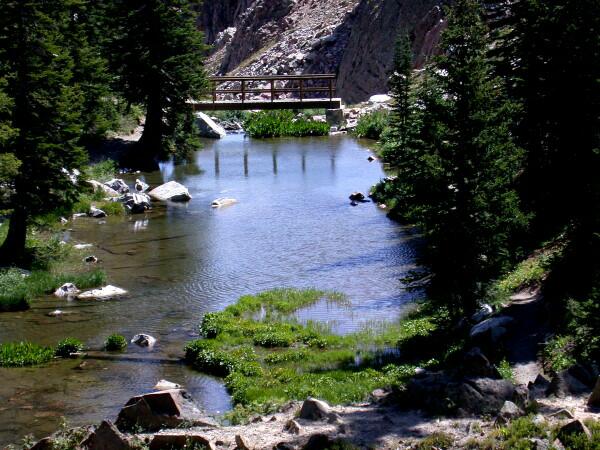
Up here there were still wildflowers blooming and here is a picture of some fireweed.
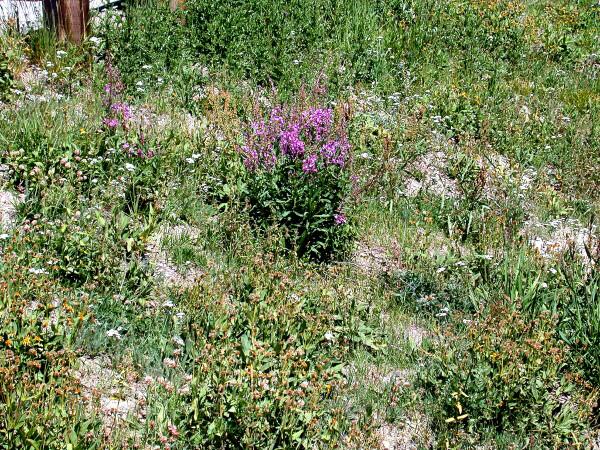
There is a trail which goes down to the bridge. There is also a trail which goes up alongside Medicine Bow Peak and this is a rather popular hiking trail. Unfortunately, I have never taken either trail, but perhaps in the years of my mad 70s, I shall take my cane and stumble up one trail and down the other. There are 2 reasons why the climb up the peak is so popular: 1) the spectacular views and 2) small fragments of the remains of what on October 6, 1955 was the worst air crash in U.S. history at the time killing 63 passengers and 3 crew members. The plane left Denver 83 minutes late at 6:33 a.m. It was scheduled to fly north and east of Laramie and over the small town of Rock River, Wyoming where it was to make a turn to the west and fly to Salt Lake City. It is thought that the pilot decided to take a shortcut to make up for lost time and for whatever reasons did not quite clear the top of the peak. When the plane did not report in as required, the Civil Aeronautic Authority was notified and thereafter two Wyoming Air National Guard planes were sent out on search missions. One of them did find the crash site. This is harsh and rugged country and it took 5 days to recover the remains of the 66 people. The military agreed to the United Airlines request to destroy the remains of the plane after the investigation was over and they used not only explosives, but napalm. Nonetheless, people still find small fragments of the craft even today.
One conjecture for the cause of the crash is windshear. The winds here in the upper part of the range can be especially ferocious.
On our way back, we stopped at Libby Flats and walked out to the observation platform.

It was a bright, pleasant summer day, but we estimated that the winds must have been 40 mph and some just nearly blew me over as we climbed up to the platform. I was very glad there was a railing to hang on to. The altitude here is 10,847 feet and there are splendid views down into Colorado and over to the west, views of the Sierra Madre mountains along the Continental Divide.
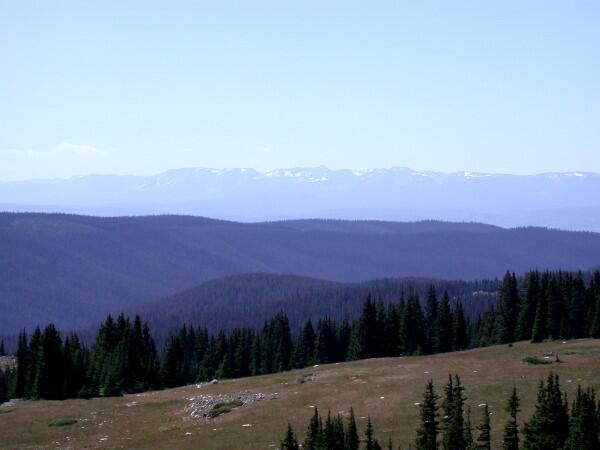
Also from here, one can look down onto a series of small lakes, ponds, and trails.

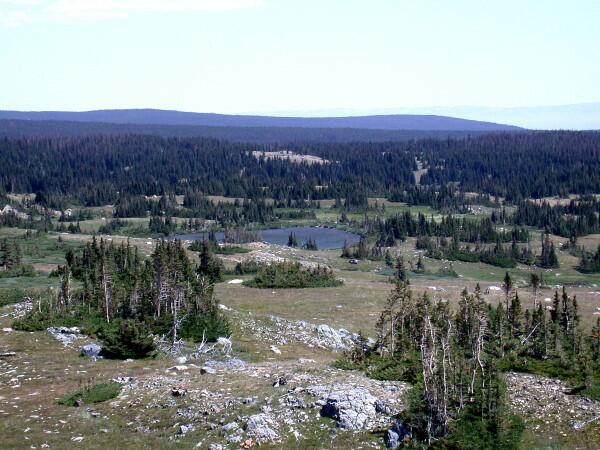
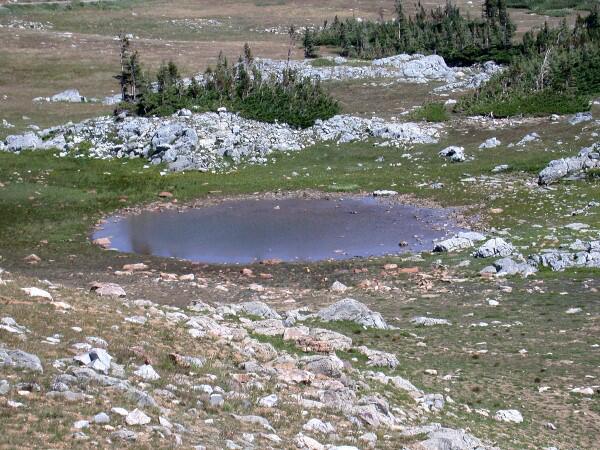
Behind us is Sugarloaf Mountain with an altitude of 10,400 feet.
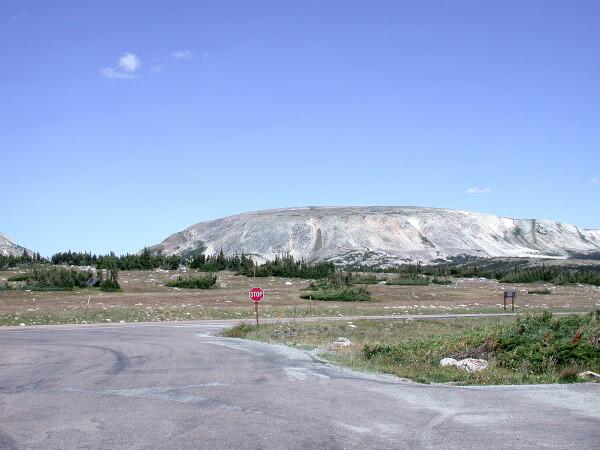

The walking, the lower oxygen levels at these altitudes, and the brisk, fresh air had made us slightly somnolent and quite hungry. We drove down a few miles to a lodge and had a substantial lunch and then back to Laramie.
All comments to the author Richard Howey are welcomed.
Editor's note: Visit Richard Howey's new website at http://rhowey.googlepages.com/home where he plans to share aspects of his wide interests.
Microscopy UK Front
Page
Micscape
Magazine
Article
Library
Please report any Web problems or offer general comments to the Micscape Editor .
Micscape is the on-line monthly magazine of the Microscopy UK website at Microscopy-UK .